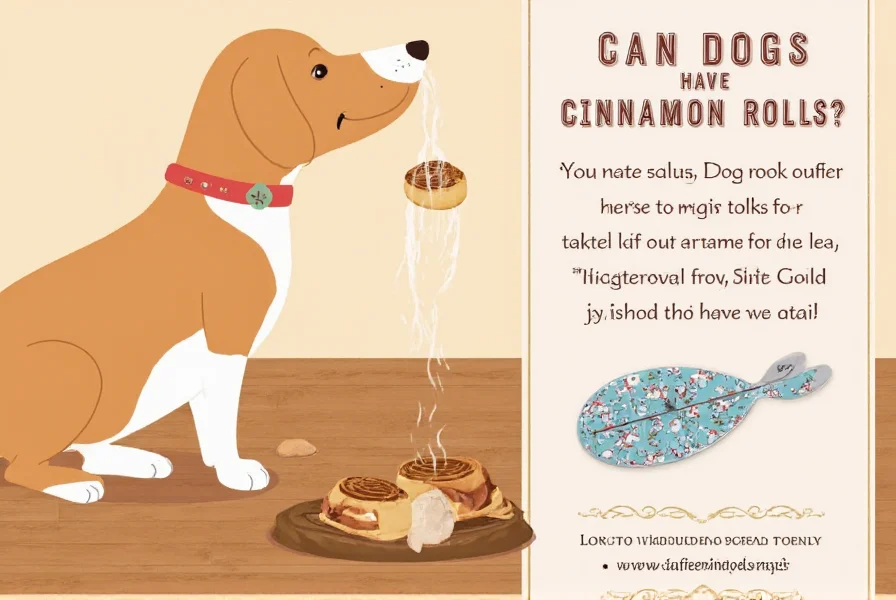As a veterinarian with over 15 years of clinical experience, I've treated numerous dogs suffering from human food ingestion incidents. Cinnamon rolls represent a particularly dangerous treat for canines due to their complex ingredient profile. Understanding exactly why these sweet pastries pose such significant risks can help pet owners make safer choices for their furry companions.
Why Cinnamon Rolls Are Dangerous for Dogs
When evaluating whether can dogs have cinnamon rolls safely, we must examine each problematic component:
| Ingredient | Risk Level | Health Impact |
|---|---|---|
| Sugar (40-60g per roll) | High | Dental disease, obesity, diabetes |
| Yeast dough | Critical | Alcohol production, gastric dilation |
| Nutmeg (common in spice mixes) | High | Neurological symptoms, organ damage |
| Butter/oil | Moderate | Pancreatitis, digestive upset |

Sugar Content Dangers
A single cinnamon roll typically contains 40-60 grams of sugar—equivalent to a small dog's entire daily caloric needs in empty carbohydrates. When pet owners wonder what happens if my dog ate a cinnamon roll, excessive sugar is often the first concern. This sugar overload causes immediate gastrointestinal distress including vomiting and diarrhea. Long-term risks include obesity, dental decay, and potentially diabetes mellitus—particularly dangerous for breeds predisposed to endocrine disorders.
Yeast Dough Expansion Risk
Many pet owners don't realize that the raw yeast in unbaked cinnamon roll dough poses a life-threatening emergency. When ingested, the warm, moist environment of a dog's stomach causes continued fermentation. This process produces both carbon dioxide (causing dangerous stomach bloating) and ethanol (alcohol). The resulting gastric-dilation volvulus (GDV) requires immediate surgical intervention. Even baked rolls retain enough yeast to cause significant digestive upset in most dogs.
Nutmeg Toxicity in Cinnamon Rolls
While cinnamon itself isn't toxic to dogs in small amounts, most commercial cinnamon roll recipes include nutmeg—which contains myristicin. This compound causes neurological symptoms in dogs after eating cinnamon rolls including tremors, disorientation, and elevated heart rate. The ASPCA reports that as little as 0.1g of nutmeg per pound of body weight can trigger toxicity. Since many cinnamon roll recipes contain substantial nutmeg, even a small bite could be dangerous for smaller breeds.
Symptoms to Watch For
If your dog consumed cinnamon roll, monitor for these symptoms within 30 minutes to 12 hours:
- Excessive drooling or lip-licking (early digestive distress)
- Vomiting and diarrhea (within 1-6 hours)
- Abdominal pain or bloating (critical emergency)
- Increased thirst and urination (blood sugar impact)
- Lethargy or unusual restlessness
- Elevated heart rate or breathing difficulties
Contact your veterinarian immediately if you notice persistent vomiting, abdominal distension, or neurological symptoms. For how much cinnamon roll is dangerous for dogs, the threshold varies by size—just one bite could seriously affect a Chihuahua, while a larger breed might tolerate a small nibble with only mild symptoms.
What to Do If Your Dog Ate Cinnamon Roll
Immediate action can prevent complications when your dog ate cinnamon roll accidently:
- Assess quantity consumed - Note how much was eaten and ingredients if known
- Check for immediate symptoms - Look for vomiting, distress, or unusual behavior
- Contact animal poison control - Have packaging or recipe details ready
- Follow veterinary guidance - They may recommend observation or immediate examination
- Never induce vomiting without professional instruction
Safer Alternatives for Treating Your Dog
Instead of sharing human pastries, consider these healthy alternatives to cinnamon rolls for dogs:
- Plain cooked sweet potato - Provides natural sweetness with fiber and vitamins
- Unsweetened applesauce - Small portions offer fruity flavor without sugar overload
- Cinnamon-dusted plain yogurt - Tiny sprinkle of cinnamon on dog-safe yogurt
- Commercial dog treats - Specifically formulated for canine digestion
When selecting dog-safe human foods instead of cinnamon rolls, always introduce new items gradually and in moderation. Remember that treats should comprise no more than 10% of your dog's daily caloric intake to maintain proper nutrition.
Preventing Future Incidents
Implement these strategies to avoid can dogs eat cinnamon rolls emergencies:
- Store baked goods in dog-proof containers or elevated locations
- Train consistent "leave it" commands using positive reinforcement
- Educate all household members about dangerous human foods
- Provide appropriate chew toys to satisfy oral fixation
- Consult your veterinarian about creating a pet-safe baking environment
When to Seek Veterinary Care
While mild cases of dog ate small piece of cinnamon roll may resolve with observation, seek immediate veterinary attention if your dog shows:
- Continuous vomiting (more than 2 episodes)
- Visible abdominal distension
- Neurological symptoms like tremors or disorientation
- Difficulty breathing or rapid heart rate
- Signs of pain when abdomen is gently pressed
Early intervention significantly improves outcomes for dogs experiencing food-related emergencies. Your veterinarian may recommend blood work, abdominal imaging, or supportive care depending on symptoms and timing of ingestion.
Frequently Asked Questions
Can dogs have a small bite of cinnamon roll?
While a tiny nibble (less than 1% of a standard roll) might not cause immediate harm to larger dogs, it's never recommended. Even small amounts contain problematic ingredients like sugar and potentially toxic nutmeg. Smaller breeds face higher risks from minimal consumption. When considering can dogs have just a little cinnamon roll, the safest answer remains no—opt for dog-specific treats instead.
How soon after eating cinnamon roll will my dog show symptoms?
Symptoms typically appear within 30 minutes to 6 hours after consumption. Initial signs include drooling and lip-licking, followed by vomiting and diarrhea within 1-3 hours. Yeast-related complications like bloating may develop within 2-4 hours. Nutmeg toxicity symptoms often appear 2-6 hours post-ingestion. If your dog ate cinnamon roll, monitor closely for at least 12 hours for signs my dog is sick from cinnamon roll.
Is cinnamon itself toxic to dogs?
Pure cinnamon in very small amounts (a light sprinkle) isn't toxic to dogs, but it's not recommended. The concern with can dogs eat cinnamon rolls comes from the combination of ingredients—not just cinnamon. Many cinnamon roll recipes contain nutmeg, which is highly toxic, along with excessive sugar, yeast, and fats. Even if a recipe contains only cinnamon, the other ingredients make the entire pastry unsafe for canine consumption.
What should I do if my dog ate cinnamon roll with raisins?
Raisins are extremely toxic to dogs regardless of other ingredients. If your dog consumed cinnamon roll containing raisins, contact your veterinarian immediately—even if no symptoms are present. Raisin toxicity can cause acute kidney failure, and early intervention significantly improves outcomes. Do not wait for symptoms to appear when dealing with dog ate cinnamon roll with raisins, as kidney damage may already be occurring.
Are there any safe baked goods for dogs?
Some specially formulated dog-friendly baked goods exist, but most human pastries are unsafe. Safe alternatives include treats made with dog-safe ingredients like pumpkin, peanut butter (xylitol-free), and oats. Never give dogs standard baked goods containing sugar, chocolate, xylitol, raisins, or excessive fats. When searching for healthy alternatives to cinnamon rolls for dogs, look for veterinarian-approved recipes using single-ingredient components like plain cooked sweet potato or unsweetened applesauce in strict moderation.











 浙公网安备
33010002000092号
浙公网安备
33010002000092号 浙B2-20120091-4
浙B2-20120091-4